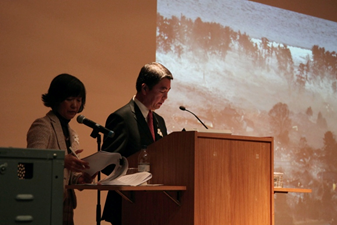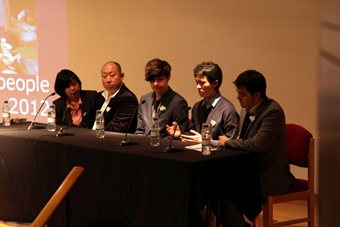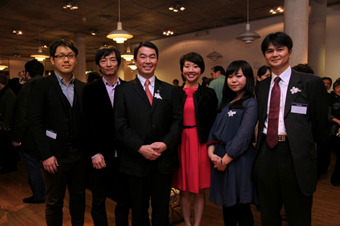| |
|
|
TSUNAMI, 611 Days Later
Alastair Lomas of TERP London writes about their recent event at the Brunei Gallery Lecture Theatre, SOAS
|
Three hundred people attended the Brunei Gallery Lecture Theatre at SOAS, University of London, on Sunday 11 November to discuss the latest earthquake and tsunami relief activities in the Tohoku region of Japan.
The event, entitled TSUNAMI, 611 Days Later - referring to the time that had passed since the Tohoku Earthquake struck on 11 March 2011 - was hosted by London-based volunteer groups TERP London and Sakura Front, and the Japan Research Centre at SOAS, with sponsorship from the Sasakawa Foundation. The organisers hoped to stress the importance of not forgetting the Tohoku Earthquake’s victims and their changing needs. The Chair of the Japan Research Centre, Dr Stephen Dodd, reminded the audience in his opening note that “all barriers between people and cultures dissolve” in the “outpouring of compassion” that follows a major catastrophe.
The event began with a screening of the 2012 Academy Award-nominated documentary "The Tsunami and the Cherry Blossom" by British film director Lucy Walker. Lucy had originally planned to visit Japan in spring 2011 to make a documentary about sakura. The events of 11 March 2011 left her facing a moral dilemma - to cancel the project altogether or make a very different film. (Editor - You can read more of Lucy's thoughts in an article from our March 2012 webmagazine.)
The documentary mixes interviews with survivors with juxtaposing scenes of spring blossoms and carnage in the Miyagi and Fukushima coastal areas. It served as a powerful reminder of the destruction and many members of the audience were moved to tears by the interviewees’ candid reflections.
The director was unable to attend the event because of commitments to her new project, but sent the audience a message: “I am so happy that people are watching the film, because everyone in the Tohoku region keeps saying to me, and to everyone else who visits: 'Please, please, don't forget about us.'"
|

Governor of Miyagi Yoshihiro Murai speaks of the damage inflicted
on the prefecture by the tsunami. (Photograph by Saera Jin)
|
Following the screening, the Governor of Miyagi Prefecture, Yoshihiro Murai, spoke of the situation in the prefecture since March 2011. Miyagi was the most heavily damaged prefecture, experiencing tsunami waves of over 10 metres along most of its coastline, up to 20 metres in some areas, and suffered 60% of the total casualties. In the immediate aftermath 320,000 people (15% of the population) were living in temporary shelters.
The Governor described feelings of helplessness as he watched parts his constituency being swept away in the deluge. The debris created was equivalent to 23 years of Miyagi’s total annual waste. Despite this, the prefectural government is aiming to complete clear-up operations by March 2014. The Governor believes that before this proper reconstruction cannot begin.
|
Mr Murai told the audience that, following a conversation with the Mayor of Kobe, he realised a return to the status quo would not be possible. Kobe was a major port prior to the Great Hanshin Earthquake of 1995; although all the facilities there had been restored within a decade, container ships never returned. The Governor of Miyagi, therefore, believes all rebuilding efforts should take the possibility of future changes into account.
Some of the changes the Governor intends to make require a complete restructuring of coastal communities, with residential areas and key infrastructure being moved to higher ground. He expressed a strong interest in creating modern ‘smart cities’ relying on sustainable energy to encourage young people to stay in – or move to - the area, which suffers from a rapidly declining population. He finished his speech with a plea for international tourists to visit in order to show support and stimulate the local economy.
|
The event ended with a discussion facilitated by Ai Shimohama, Chair of TERP London. The panel featured Iwao Niizawa, a fifth-generation sake brewer whose 140 year-old brewery was destroyed in the earthquake; Angus Miyaji, Scottish-Japanese founder of Seven Beach Aid, whose family lives in the area; and Ryan Browne and James Li, two Imperial College London students who are members of Action for Japan UK. James and Ryan travelled to Tohoku as part of the 2012 Rikuzentakata Volunteer Project in July. Ryan also visited Mr Niizawa’s brewery in August 2011.
The debate tackled the difficulties of assessing the needs of the victims, which all panel members admitted were constantly changing. Angus Miyaji, who is in regular contact with family and friends in the area, began by sending money to pay for basic essentials such as underwear, children’s toys and warm drinks. |
 The debating panel. From second left: Iwao Niizawa, Ryan Browne,
The debating panel. From second left: Iwao Niizawa, Ryan Browne,
James Li and Angus Miyaji. (Photograph by Saera Jin)
|
As time progresses, however, he finds that raising awareness of the disaster outside the region - or preventing people from forgetting it - is more important.
Mr Miyaji named a recent project, Yarn Alive, which provides the 700-plus women in temporary housing in Shichigahama with the equipment and know-how to knit. The objects produced are shared with groups in temporary housing in other areas. Miyaji says, “When people who have been affected by the tsunami are able to start giving, that’s when their lives become normal.” The panel agreed that psychological needs are becoming more important than material needs - Mr Niizawa spoke warmly of the vital energy and new ideas that overseas volunteers brought to his employees and community.
All of the panel members are working on new projects to adapt to the changing situation in Tohoku. Ryan and James are organising an Action for Japan UK event in to report on their experiences in the region over the summer. Mr Niizawa hopes to export his sake to London and increase the quality of his product, which is served in first class by Japanese flag carrier JAL.
|
 The Governor of Miyagi (third from left) with members of Sakura Front (left)
The Governor of Miyagi (third from left) with members of Sakura Front (left)
and TERP London (right). (Photograph by Saera Jin)
|
Mr Miyaji is promoting the Cricket for Smiles campaign, which may be of particular interest to those in the UK who want to offer support. The Japanese Cricket Association, supported by a grant from the Scottish Government, is teaching the sport in Kesennuma elementary schools to give the children hope and enjoyment. The organisers hope to raise £7,000 for a cup competition in 2013. The winners of this competition would progress to a national contest. (Editor - for more information about cricket in Japan, see this article in our September 2012 webmagazine.)
Following the event the organisers provided networking time for visitors to discuss potential relief projects while enjoying Mr Niizawa’s sake. British volunteers, with their long tradition of charity work, may be able to provide the experience and energy Tohoku needs to prepare for a brighter future.
|
Tohoku Earthquake Relief Project London (TERP London) supports people who wish to forge bonds between London and Tohoku. They provide project support to help rebuild the region, publish a bi-monthly newsletter and hold a liaison committee to provide updates on the situation. Find more information on their website.
Sakura Front was set up in London shortly after the disaster to focus people’s minds on the long-term recovery of Japan. The group designed the Sakura Brooch - inspired by the Remembrance Poppy - as a symbol for people to wear on the 11th March each year as a reminder of the tragic events that took place and to show their ongoing concern and support for the Japanese people. More information about their activities can be found on their website.
The Japan Research Centre (JRC) has been the forum for Japan-related research activities at SOAS since 1978. The JRC develops and coordinates academic research and teaching, drawing upon the expertise of the Japan specialists who are based in various departments throughout the School. For more information, visit their website. |
|
|
| Top |
|
| |
|
|
|
|
| |
|  |
|

